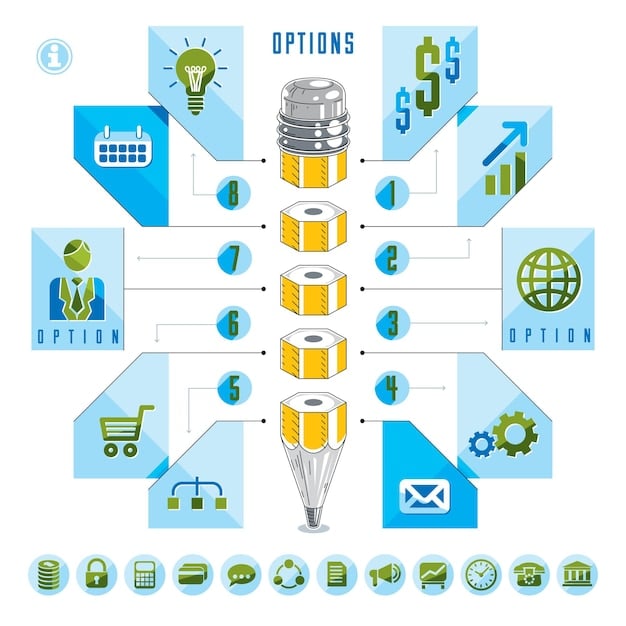US Fintech & Data Privacy: Compliance Strategies for 2025

How Can US Fintech Companies Comply with the Latest Data Privacy Regulations? Navigating the evolving landscape of data privacy is critical for US fintech firms. Key strategies include implementing robust data governance, ensuring transparency with users, and adapting to state and federal mandates.
The fintech industry in the US is booming, but with great innovation comes great responsibility – especially when it comes to data privacy. How Can US Fintech Companies Comply with the Latest Data Privacy Regulations? This is a question that keeps many CEOs and compliance officers up at night. Staying ahead of the curve isn’t just about avoiding hefty fines; it’s about building trust with your customers and maintaining a competitive edge.
This article will explore practical strategies and best practices to help US fintech companies navigate the complex web of data privacy regulations. We’ll break down key compliance requirements and examine how to build a robust data privacy framework that not only meets legal obligations but also enhances customer trust and fosters long-term growth. So, whether you’re a startup or an established player, let’s dive into how to ensure your fintech company is compliant and customer-centric.
Understanding the US Data Privacy Landscape for Fintech
The United States doesn’t have a single, comprehensive federal data privacy law like Europe’s GDPR. Instead, it operates under a patchwork of federal and state laws, each addressing specific aspects of data privacy. For fintech companies, understanding this landscape is the first step in ensuring compliance.
Key Federal Regulations Affecting Fintech
Several federal laws impact how fintech companies handle personal data. These include:
- The Gramm-Leach-Bliley Act (GLBA): This act requires financial institutions to explain their information-sharing practices to customers and safeguard sensitive data.
- The Fair Credit Reporting Act (FCRA): This law regulates the collection, use, and sharing of consumer credit information.
- The Electronic Fund Transfer Act (EFTA): This act protects consumers engaging in electronic fund transfers and provides error resolution procedures.

The Rise of State Data Privacy Laws
In recent years, states have been taking the lead in enacting comprehensive data privacy laws. California’s Consumer Privacy Act (CCPA) and its successor, the California Privacy Rights Act (CPRA), have set a high standard, granting consumers significant rights over their personal data. Other states, like Virginia, Colorado, and Utah, have followed suit with their own comprehensive laws. Fintech companies operating nationwide need to be aware of and comply with these diverse state requirements.
For US fintech companies, mastering the US data privacy landscape is essential. By knowing the main federal laws and closely watching state laws as they change, and by embracing innovative ways to stay ahead, fintech companies can demonstrate their commitment to protecting customer data. This creates trust and helps them flourish in a regulated environment.
Building a Robust Data Privacy Program
Now that we’ve explored the regulatory landscape, let’s delve into the practical steps US fintech companies can take to build a robust data privacy program. A comprehensive program should address all aspects of data handling, from collection to storage to disposal.
Data Inventory and Mapping
The first step is to understand what data you collect, where it’s stored, and how it’s used. This involves conducting a thorough data inventory and mapping exercise. Consider:
- Data Collection Points: Identify all points where you collect personal data, such as online forms, mobile apps, and customer service interactions.
- Data Storage Locations: Document where data is stored, including databases, cloud storage, and physical servers.
- Data Flows: Map how data flows within your organization and to third-party vendors.

Implementing Data Minimization and Purpose Limitation
Data minimization is the principle of collecting only the data that is necessary for a specific purpose. Purpose limitation means using data only for the purpose for which it was collected. To implement these principles:
- Review Data Collection Practices: Evaluate the data you collect and eliminate any data that is not essential.
- Define Data Usage Policies: Clearly define the purposes for which data is used and ensure that data is not used for any other purposes.
- Implement Data Retention Policies: Establish policies for how long data will be retained and securely dispose of data when it is no longer needed.
By building a strong data privacy program, US fintech companies not only address their legal obligations but also send a great message about their dedication to data protection. This boosts customer trust and distinguishes them in a field where data security is extremely important.
How Can US Fintech Companies Comply with the Latest Data Privacy Regulations?
The question remains: How Can US Fintech Companies Comply with the Latest Data Privacy Regulations? Compliance isn’t a one-time task; it’s an ongoing process that requires continuous monitoring and adaptation.
Staying Updated on Regulatory Changes
Data privacy laws are constantly evolving. Fintech companies need to stay informed of the latest changes and adapt their compliance programs accordingly. Here’s how:
- Monitor Regulatory Updates: Subscribe to updates from relevant regulatory bodies and industry associations.
- Conduct Regular Legal Reviews: Engage legal counsel to conduct regular reviews of your compliance program.
- Participate in Industry Forums: Attend industry conferences and forums to learn from peers and experts.
Implementing Technical Safeguards
Technical safeguards are essential to protect personal data from unauthorized access, use, and disclosure. Strong technical safeguards include:
- Encryption: Encrypt sensitive data both in transit and at rest.
- Access Controls: Implement strict access controls to limit who can access data.
- Security Monitoring: Implement security monitoring tools to detect and respond to security incidents.
In summary, the best data privacy compliance practices for US fintech companies need a commitment to staying informed, utilizing strong technical protections, and instilling a culture of data security across the company, which is key to protecting customer data and maintaining a competitive edge.
The Role of Data Governance and Training
Effective data governance and employee training are critical components of a successful data privacy program. These elements ensure that data privacy is not just a legal requirement but a core value within the organization.
Establishing a Data Governance Framework
A data governance framework defines the roles, responsibilities, and processes for managing data within an organization. Key elements of a data governance framework include:
- Data Privacy Officer: Appoint a Data Privacy Officer (DPO) who is responsible for overseeing the data privacy program.
- Data Governance Policies: Develop and implement policies and procedures that govern how data is collected, used, and shared.
- Data Quality Controls: Implement controls to ensure that data is accurate, complete, and up-to-date.
Employee Training and Awareness
Even the best data governance framework is ineffective if employees are not aware of their responsibilities. Comprehensive employee training and awareness programs are essential. Consider:
- Regular Training Sessions: Conduct regular training sessions on data privacy laws, company policies, and best practices.
- Phishing Simulations: Conduct phishing simulations to test employee awareness and identify areas for improvement.
- Incident Response Training: Train employees on how to respond to data breaches and other security incidents.
US fintech companies are encouraged to embrace data governance and training as essential parts of their overall compliance plan. By setting clear guidelines, giving employees thorough training, and fostering a security culture, fintech companies can successfully protect sensitive information and meet the growing expectations of customers and regulators.
Transparency and User Consent
Transparency and user consent are fundamental principles of modern data privacy laws. Fintech companies must be transparent about their data practices and obtain valid consent from users before collecting and using their personal data.
Crafting Clear and Concise Privacy Policies
Privacy policies should be written in plain language that is easy for users to understand. They should clearly explain:
- What data is collected: Describe the types of personal data you collect.
- How data is used: Explain how the data is used and the purposes for which it is processed.
- With whom data is shared: Disclose any third parties with whom data is shared.
Obtaining Valid User Consent
Consent must be freely given, specific, informed, and unambiguous. To obtain valid consent:
- Use Clear Opt-In Mechanisms: Avoid pre-checked boxes and use clear opt-in mechanisms.
- Provide Granular Consent Options: Allow users to consent to specific data processing activities.
- Make it Easy to Withdraw Consent: Provide a simple and easy way for users to withdraw their consent.
Overall, US FinTech companies can comply with the latest data privacy regulations by prioritizing transparency and user consent, which demonstrates a commitment to protecting user rights and building trust. Clear privacy policies and reliable ways to get consent are essential steps to creating an honest and respectful data environment.
Incident Response and Data Breach Management
Even with the best data privacy program, data breaches can still occur. Having a well-defined incident response plan is crucial to minimize the impact of a breach and comply with legal requirements.
Developing an Incident Response Plan
An incident response plan should outline the steps to be taken in the event of a data breach. Key elements of the plan include:
- Identification: Procedures for identifying and assessing a data breach.
- Containment: Steps to contain the breach and prevent further data loss.
- Eradication: Actions to remove the cause of the breach and restore systems.
Complying with Data Breach Notification Laws
Most states have data breach notification laws that require companies to notify individuals and regulators in the event of a data breach. Compliance involves:
- Prompt Notification: Notifying affected individuals and regulators within the required timeframe.
- Providing Required Information: Including all required information in the notification, such as the nature of the breach and steps being taken to mitigate the harm.
- Offering Credit Monitoring: Providing credit monitoring services to affected individuals, as required by some laws.
By establishing strong incident response plans and adhering to data breach notification rules, US FinTech companies demonstrate their dedication to protecting customer data even when faced with security incidents, which are essential for preserving trust and adhering to legal requirements.
| Key Point | Brief Description |
|---|---|
| 🔑 Regulatory Understanding | Know federal (GLBA, FCRA) and state (CCPA) data privacy laws. |
| 🛡️ Data Protection Measures | Implement encryption, access control, and data minimization. |
| 👨💻 Governance & Training | Appoint a DPO and provide regular data privacy training. |
| 🚨 Incident Response | Establish a clear incident response plan and comply with data breach notification laws. |
Frequently Asked Questions
Fintech companies in the US must comply with the Gramm-Leach-Bliley Act (GLBA), the Fair Credit Reporting Act (FCRA), and various state data privacy laws like the California Consumer Privacy Act (CCPA).
To ensure data security, fintech firms should use encryption, implement strict access controls, regularly update security software, and conduct frequent security audits.
How Can US Fintech Companies Comply with the Latest Data Privacy Regulations? They need to obtain explicit user consent through clear opt-in mechanisms, provide granular consent options, and make it easy to withdraw consent.
A data breach incident response plan should include procedures for identifying, containing, eradicating, and recovering from data breaches, along with guidelines for notifying affected parties and regulators.
Employee training is crucial to ensure all staff understand their roles and responsibilities in protecting personal data, adhering to company policies, and recognizing and responding to security threats.
Conclusion
Staying compliant with data privacy regulations can seem overwhelming for US fintech companies. How Can US Fintech Companies Comply with the Latest Data Privacy Regulations? By implementing a sound data privacy program, staying informed on regulatory changes, and focusing on transparency and user consent, fintech companies can navigate this complex landscape successfully.
Ultimately, prioritizing data privacy is not just about legal compliance; it’s about building trust with your customers and creating a sustainable business model in the long run. With the right strategies in place, US fintech companies can thrive in an environment where data protection is paramount.





